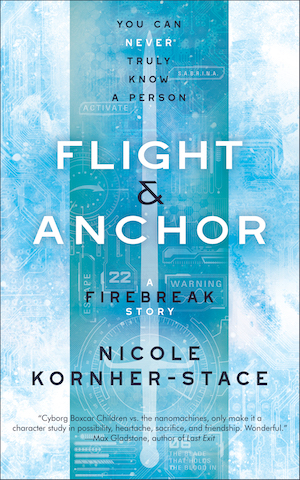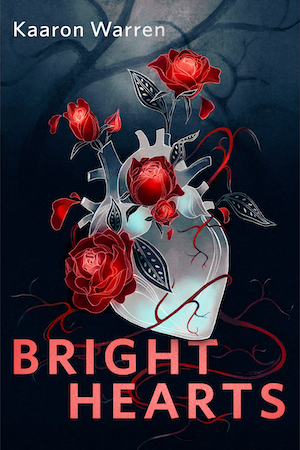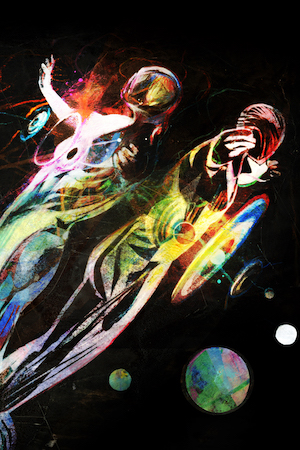Nicole Kornher-Stace’s new novella Flight & Anchor describes itself, on the cover, as “A Firebreak Story.” This is true; the story concerns two characters who appear in Kornher-Stace’s excellent 2021 novel Firebreak. But technically, it could also say “An Archivist Wasp” story, as those same characters appear—in somewhat different form—in Archivist Wasp and its sequel, Latchkey.
It is also true, technically or otherwise, that you could read this absorbing, perfectly calibrated, Boxcar Children-inspired novella as an introduction to Kornher-Stace’s work as a whole. All the elements are here: intentionally endless corporate conflict; propaganda and stories that control; stories that offer hope; child soldiers; a brutal blending of death and myth; intense friendship; and, though it all, 06 and 22, two specific soldiers who at this point are in fact still children, and have run away—though not from home. Home is long gone, just the faintest of sun-tinged memories.
No: These two are 12-year-old killing machines, and they’ve run away from the woman who made them.
“Freedom, it turns out, is harder than anticipated,” Kornher-Stace writes, as the two preteens melt snow for water (an act of anti-corporate terrorism, in this world, and punished cruelly when done by those who are not outside the law). But “hard” is not something 06 and 22 are likely to run away from—more likely they’ll run straight toward it.
Buy the Book


Flight & Anchor
Which is what they do, and what they’ve done, in breaking out of the place they’ve been for four years. They are two of 11 soldier-children, all that’s left of 48 kids who were kidnapped into a gazillions-dollar supersoldier program that is also a propaganda program that will, eventually, echo through years and decades, long past the death of this corporate hellhole of a world. “They’ve already lost everything but each other” is a simple, painfully accurate sentence that sets the tone for the whole, brief, intense story.
06 and 22 have nothing but the clothes on their backs—uniforms hidden under coats lifted from the Director’s closet—and their incredible skillsets, which include enhanced everything (hearing, strength, speed) and a lot of ways to murder. But murder gets people’s notice. Attention is not their friend; when, in the first chapters, a barista named Cass is kind to them, they slip out from under Cass’s watch at their first chance, taking with them a lot of day-old baked goods and an entire lost-and-found worth of clothes.
Giving us a civilian’s impression of this pair is a wise way to start. They’re disconcerting small figures. Momentarily, Cass thinks they might be vampires. Cass also knows someone who has conspiracy theories about kidnapped children—conspiracy theories that are distressingly accurate. But the barista doesn’t put those things together until later. Another wise thing Kornher-Stace does here is give us glimpses of the future: the moment, long after the kids are gone, when Cass realizes who and what they were; a brief flash to a future in which a memory from this time haunts the Director when her own death is near.
What do two preteen supersoldiers with few memories of the “normal” world do once they’ve escaped? They hunger. They scavenge. They pile up spare change and try to shop for the most nutritious meals. They realize just how much they don’t know, and they also realize that the Director’s attempt to scrub all memories of their pasts has not been entirely successful: “Nostalgia should have been drugged and beaten out of them by now, but it clings tighter than even the Director can claw loose.”
Kornher-Stace’s world is not kind, except when it is. (See: Cass.) As in Firebreak and Archivist Wasp, the author pulls no punches about violence and cruelty, but they also never revel in it. The practical way that 06 (the firebrand, the flight) and 22 (the rock, the anchor) approach their predicament is as gripping as it is terrible. They’re twelve. And they hardly know anything outside of their training. But they learn so much: They learn that their fellow supersoldiers’ faces are on burger wrappers, their own faces on soda cups. They learn that there is more technology hidden in Stellaxis’ corporate vaults than anyone has kept track of. (The third best character in this book is a very sly nanobot swarm.) And they learn that they can look out for each other—to a point. Some things, loyalty alone can’t fix.
Ultimately, the books Kornher-Stace has set in this vicious corporate world are about love, though at twelve, our young, abused, powerful heroes don’t yet understand this. They are a platonically bonded pair: They will do anything for each other, including throw themselves in front of deadly weapons and face the things they’ve run from. If you’ve read Wasp, this little glimpse of their childhood adds painful, beautiful depth to characters you’ve already met. If this is your first time meeting them, I don’t know how you could help but want to know more. How can loyalty be this fierce when they’re this young? How can they go through such hell and come out like they do?
How can the world look away while all of this happens? The answer to that one is simple enough: Everyone else, too, is just trying to survive. Flight & Anchor is a small-scale book, not a big-picture one, but you’ll still get the shape of the world: the iron fist with which corporations control resources, the technological advancements, the way endless war knocks people loose from their own anchors. Everyone in this polluted world wants to see stars; everyone has to use their implants and lenses to project where those stars used to be visible. That’s hope, of a very specific kind, and it runs through all Kornher-Stace’s work: a spark in the darkness, a break in the fever.
Flight & Anchor is published by Tachyon Publications.
Molly Templeton lives and writes in Oregon, and spends as much time as possible in the woods. Sometimes she talks about books on Twitter.










